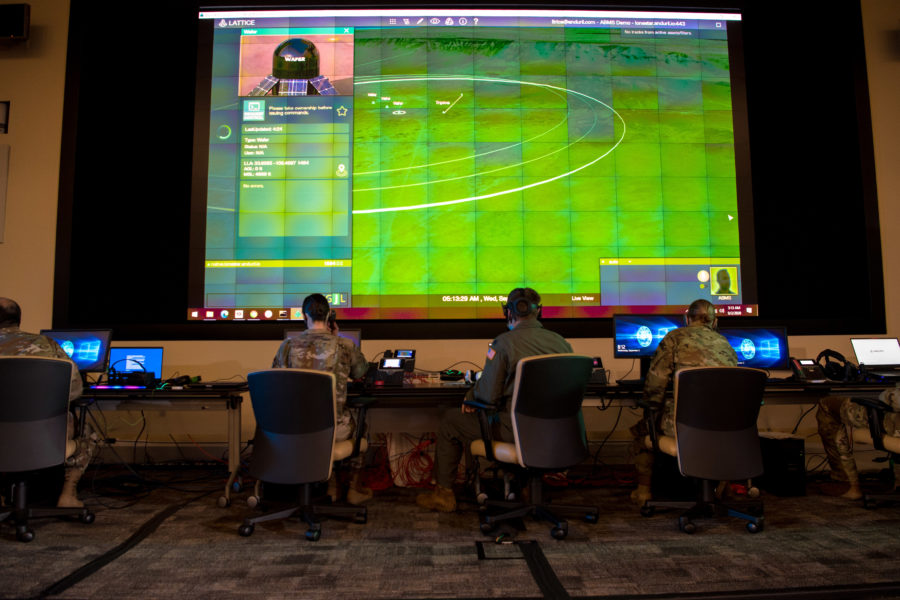The Space Force must be given leadership over disparate elements of the U.S. military’s joint all-domain command and control (JADC2) effort, according to a new policy paper from AFA’s Mitchell Institute for Aerospace Studies.
JADC2 is an effort by the Department of Defense to improve command and control by collecting more data and sharing that information across the services down to the tactical level. This joint effort, however, is being developed separately by the individual services, each coming up with its own concept of how JADC2 could work. What JADC2 will become in practice is still somewhat amorphous.
In the paper, the Mitchell Institute’s Senior Fellow for Spacepower Studies Tim Ryan suggests these efforts be consolidated under the Chief of Space Operations, with the power to define key authorities and standards of JADC2 efforts. In Ryan’s view, the CSO should be given “the primary responsibility of overseeing the integration of the entire JADC2 system.” Without better coordination among the services’ efforts, JADC2 programs risk being neither joint nor all-domain.
Because the Space Force’s satellites will be part of the “transport layer” of JADC2 that the U.S. military says will underpin its future operations, the service needs more precise strategic guidance about its mission, more responsibility, better training, and increased funding, according to Ryan. The goal would be to empower the Space Force to help make JADC2 a reality and to fulfill its vital role as a facilitator of U.S. operations by giving it the means to protect its assets.
“This sounds very expensive,” Ryan said during a roundtable with reporters to preview the paper. “It sounds very complex. I understand that. And I agree that it is.”
America’s adversaries, primarily China, have their own military space components. The People’s Liberation Army’s Strategic Support Force wants to be able to disrupt an enemy’s command and control networks in space.
“It is much, much cheaper to do it right the first time because, quite frankly, I don’t think we’re going to get a second chance on this,” said Ryan. “The second chance is we lose.”
U.S. military leaders, inside and outside of the Space Force, have begun voicing concern that America’s space assets, which include capabilities as fundamental as GPS, could be disrupted by an attack. The Biden administration is pursuing improved global norms in space, such as a ban on testing most anti-satellite weapons and stricter rules requiring operators to deorbit their defunct satellites. States such as China, however, often ignore international agreements, even if they are enacted, especially the current non-binding efforts the U.S. is pursuing.
Ryan’s paper argues that the DOD must articulate the need for, and Congress must approve, funding for the defense of space assets critical to JADC2. American military and civilian officials publicly acknowledge that space will become contested in future conflicts. Senior Space Force leaders have begun to float concept of “space superiority.”
“What that really means is the ability to take a punch and to continue to fight,” said Lt. Gen. Nina M. Armagno, the director of staff of the Space Force, at AFA’s Air, Space, & Cyber Conference in September.
Missing from that statement is an explicit ability for America to fight back directly when it is attacked in space, as it does in other domains.
Ryan, a retired Air Force lieutenant colonel who served in a variety of space roles and also worked as a civilian on the Space Force staff at the Pentagon, recommends in his paper that the Space Force receive authorization and funding to “develop space-based weapons systems that are specifically designed to defend the JADC2 space transport layer against kinetic and non-kinetic acts of aggression.”
While the Biden administration’s efforts to improve the safety of space operations through international norms are laudable, the U.S. still needs a clear space deterrent as America’s adversaries may be willing to ignore international norms, according to Mitchell Institute experts.
“Where’s the hard power in the current construct? It really doesn’t exist,” said Douglas A. Birkey, the executive director of the think tank. “Otherwise, we’re actually risking an increased likelihood of conflict in space because there are no real consequences they’re going to care about.”
Established in 2019, the Space Force is mainly made up of systems and personnel from other services. The President’s budget request for fiscal 2023, which Congress has not yet passed, allocates $24.5 billion for the Space Force, a $7 billion increase over 2022. These budget increases, however, do not necessarily reflect new capabilities, as other services have shifted the burden and the cost of space assets to the Space Force.
According to Ryan, a larger budget is required. However, he acknowledged that putting that into legislation would be challenging.
“Any current increase in the current Space Force budget [has] been primarily done through stand-up actions and being able to integrate the other services’ capabilities into the Space Force,” Ryan said. “At the end of the day, quite frankly, the money has not been equal to the demands that are being placed on the Space Force and the increased demands that it will have with JADC2.”
In the view of Birkey, space cannot be seen as devoid of consequences on Earth if U.S. space assets are attacked and systems go down.
“We have got to get real because everything else is going to fall offline fast and lives will be on the line,” he said.

